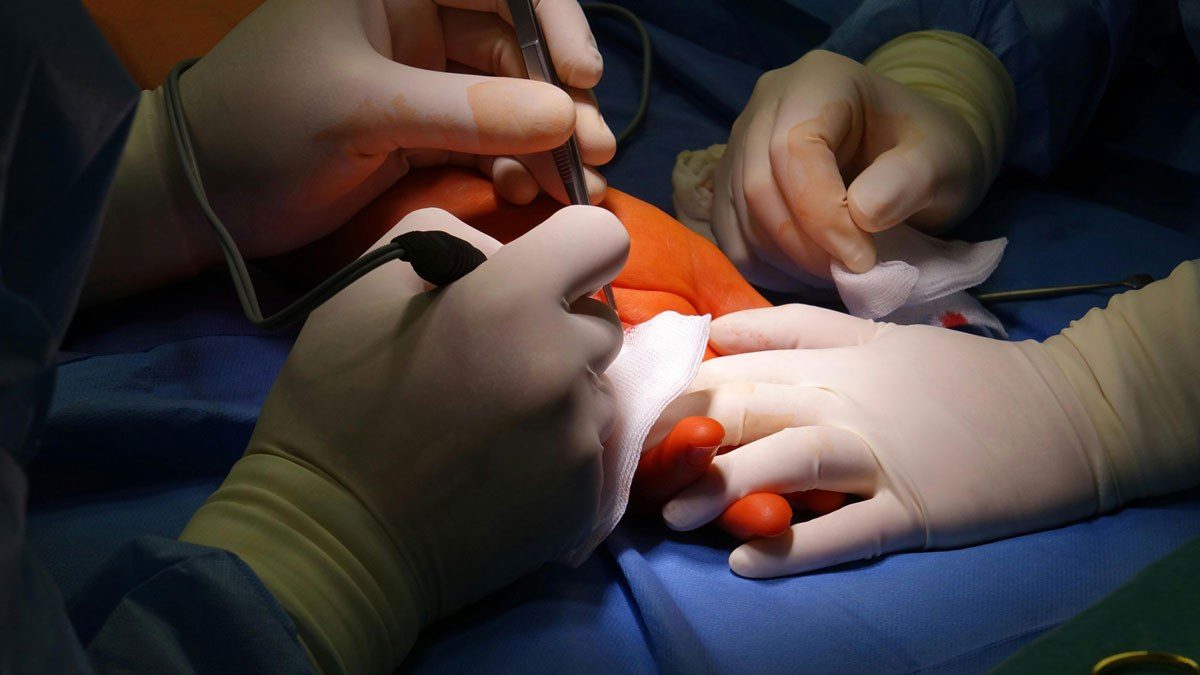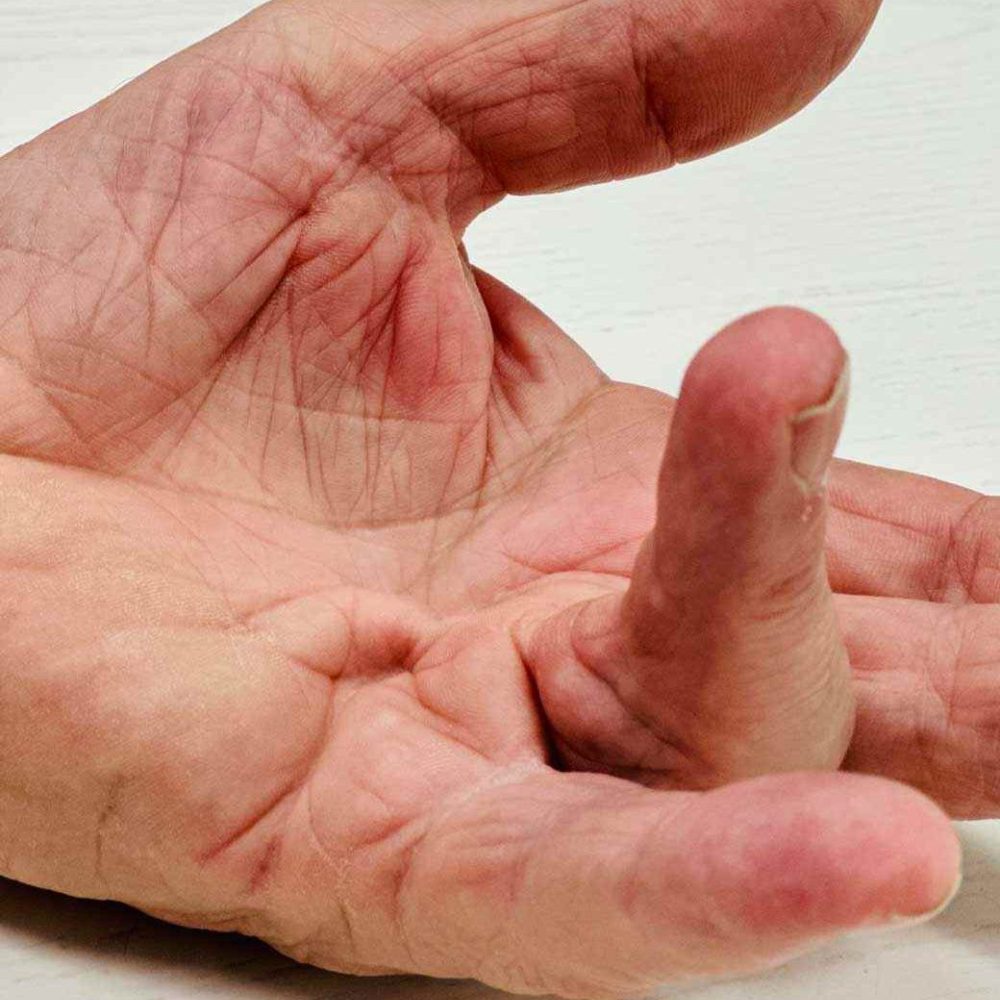What Causes Dupuytren’s Disease?
Dupuytren’s disease affects the palmar fascia—a thin layer of connective tissue beneath the skin of the palm. In affected individuals, this tissue thickens and tightens, eventually forming cords that pull the fingers toward the palm. This contracture typically occurs slowly over many months or years and is often painless, although some people may feel discomfort or tenderness in the early stages.
The exact cause of Dupuytren’s disease isn’t fully understood, but we do know it’s linked to a combination of genetic, biological, and environmental factors.
One of the strongest risk factors is heredity. If you have a family history of Dupuytren’s, your chances of developing it are higher. The condition is more common among people of Northern European and Scandinavian descent.
Other risk factors include:
- Age – It usually appears after the age of 50.
- Gender – It’s more common and tends to be more severe in men.
- Diabetes – There’s a higher prevalence in people with diabetes.
- Alcohol use and smoking – These lifestyle factors may increase risk or worsen the condition.
- Hand trauma – Some believe repeated hand injury or vibration exposure may play a role, although this is still debated.
While lifestyle factors may contribute to disease progression, the core driver is genetic predisposition, which brings us to the next point…
Why Is It Called Vikings' Disease?
Some people have suggested that Dupuytren’s disease might have come from the Vikings because it's common in people with Northern European ancestry. To test this idea, researchers in 2019 examined detailed genetic data from individuals across the UK, including areas with strong Norse ancestry.
They compared the DNA of people with Dupuytren’s disease to that of those without it, checking for any signs of Viking heritage in the genes linked to the disease. They also looked at whether areas with more Viking ancestry had higher genetic risk for the condition.
After conducting several different types of analyses, the researchers found no evidence that Dupuytren’s disease is more prevalent in individuals with Viking ancestry. So, while the condition is sometimes called “Vikings’ disease,” there’s no scientific proof that it actually came from the Vikings.
What was the Disease in actual Vikings?
While we can’t say for certain that Viking warriors suffered specifically from what we now classify as Dupuytren’s disease, there are historical descriptions of hand contractures and deformities that match the modern symptoms. Skeletal remains and Norse sagas also hint at hand conditions that could have made gripping a sword—or a mug of ale—a bit more complicated.
That said, "Vikings’ disease" is a modern term, rooted more in population genetics than in historical medicine. It simply reflects that the disease is more common among descendants of Viking lineages.

Is Vikings’ Disease Curable?
While Dupuytren’s disease cannot be cured in the traditional sense (because the underlying tendency to develop it is embedded in your genes), it can be effectively managed. Many people live for years with mild symptoms and never require intervention, while others experience more advanced contractures that benefit from medical or surgical treatment.
The goal of treatment is to restore hand function, enabling straightening of the fingers, and prevent progression, where possible. Options range from non-surgical treatments in the early stages to surgical procedures for more advanced cases.
Non-surgical methods may include:
- Needle aponeurotomy – a minimally invasive procedure where a needle is used to break or disrupt the cords.
In moderate to severe cases, especially when the finger is significantly bent and interferes with daily activities, surgical intervention may be the best option. Surgery for Dupuytren’s disease typically involves either:
- Removing the thickened, diseased fascia and cords (fasciectomy), which is the fibrous tissue causing the finger contracture. This removal relieves tension, allowing the finger to straighten.
- Or dividing (releasing) the thickened cords without removing them entirely, as in fasciotomy or needle aponeurotomy. This also helps straighten the finger by breaking the contracture.
In many cases, the surgeon will carefully release or excise the affected tissue and cords beneath the skin to improve finger extension and hand function. Sometimes, a skin graft may be necessary if the disease is severe and skin removal is part of the procedure.
While recurrence is possible—since the disease can progress in other areas—many patients experience lasting improvements in hand function and quality of life.
When to See a Plastic Surgeon about Vikings’ Disease
If you’ve been diagnosed with Dupuytren’s disease, or you’re noticing signs such as tightening in your palm, difficulty straightening your fingers, or nodules forming under the skin, it’s important to seek specialist advice.
As a registered specialist plastic surgeon, Dr Turner offers expert care for various hand conditions, including Dupuytren’s disease. Dr. Turner specialises in restoring both form and function, with extensive experience in hand surgical treatments, with every treatment plan is tailored to your specific symptoms, lifestyle, and goals.
Living with Dupuytren’s disease can be frustrating, especially when it starts to interfere with your everyday tasks. But you don’t have to accept a gradual decline in hand function. Effective surgical solutions to address Viking’s disease are available when taking action to restore movement.
